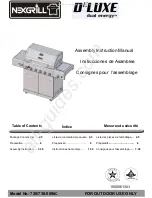
25
Problems Possible
Solutions
Burner blows out.
1. Check for any burner defects.
2. Check for proper burner installation.
3. Make certain the fuel mixture is not too lean.
4. Make sure the gas supply is sufficient.
5. See if the LP tank is empty.
Low heat, LP gas.
The propane regulator assembly incorporates an excess flow device
designed to supply the grill with sufficient gas flow under normal
conditions, yet control excess gas flow.
Rapid changes in pressure can trigger the excess flow device,
providing a low flame and low temperature. If the tank valve is turned
open to allow gas flow while a burner valve is open, the surge of
pressure will cause the device to activate. The device will remain
closed until the pressure is equalized. This should occur within 5
seconds.
To ensure this does not cause difficulty in lighting the grill,
follow these instructions:
1. Make sure all burner valves are “OFF.”
2. Open the tank valve and wait 5 seconds.
3. Light the burner one at a time following the lighting instructions
listed on the control box and Page 14.
Low heat, natural gas.
Gas pressure is affected by gas line and length of gas line from
house gas line. Follow the recommendations in the chart below.
Form House to Grill
Distance Tubing Size
Up to 25'
3/8" diameter
26' -50'
1/2" diameter
51' -100'
2/3" of run 3/4"
1/3" of run 1/2"
Low heat generated with knob in
“HI” position.
1. Make certain the problem is isolated to only one burner. If it
appears so, clean the orifice and burner, clearing ports of any
obstruction.
2. Check for a bent or kinked fuel hose.
3. Make sure the air shutter is properly adjusted.
4. Check for proper gas supply and pressure.
5. Pre-heat the grill for a full 15 minutes.
6. If using LP gas, check for an empty tank.





































